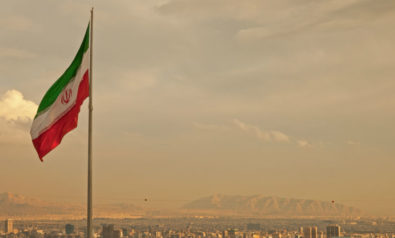How did Aum Shinrikyo, which began as a peaceful Buddhist sect, devolve into violence?
Twenty years after Japan was shaken by Aum Shinrikyo’s nerve gas attack on March 20, 1995, which killed 13 people and injured thousands, the last of the court proceedings are finally coming to an end. In April 2015, Takahashi Katsuya was sentenced to life imprisonment. Takahashi was one of those who helped the subway attackers escape; he was arrested in 2012 after 17 years on the run.
Thirteen people, including the group’s charismatic leader, Asahara Shoko, were sentenced to death—though whether they will be executed is unclear. What is certain is that 20 years after the event, the actions of Aum continue to resonate in Japan. While the religious terrorism spotlight has recently shifted to Islamist groups like al-Qaeda and the Islamic State, Aum remains a striking example of modern religious extremism and violence. It was the first nongovernmental organization ever to use lethal chemical weapons on the general public. As such, its activities caused great worry among security forces worldwide, for whom Aum appeared to suggest the dawn of a new era of mass terrorism using new forms of weaponry.
Solace in Religion
So, how did a legally registered religious movement rapidly descend into terrible violence?
To understand this, it is important to reiterate that Aum Shinrikyo (the name translates as “Aum teaching of truth,” although its official English title was Aum Supreme Truth) was not initially a violent movement. “Aum” is a Sanskrit term used in Hindu and Buddhist contexts as a mantra, and it contains meanings of creation, preservation and destruction—themes central to the movement’s teachings, with destruction (of evil) viewed as central to the creation of good.
Aum Shinrikyo was founded in the early 1980s by Asahara, a partially blind man from an impoverished background who had suffered discrimination because of his disability, and who had sought solace in religion. He became a talented teacher of yoga and meditation in Tokyo and attracted largely young and well-educated idealists, many of whom had professional careers but who were looking for spiritual nourishment in a society they saw as too materialistic. Repulsed by materialism, Asahara’s teachings stated that people needed to turn to a more spiritual way of life based in asceticism and meditation.
Like many other late 20th century religious groups, Aum feared that the end of the millennium would bring disaster—like several other religious leaders in 1980s Japan, Asahara spoke about a coming apocalypse unless behaviors changed, believing he had been sent to bring this change. In Asahara’s view, the world was corrupted by materialism, which created negative karma that could lead to chaos and apocalypse by the end of the century. Yet this could be averted, he taught, via a peaceful spiritual transformation through Aum’s mission: If it could, before the end of the century, develop a large force of spiritual masters, it could eradicate the world’s negative karma and bring universal salvation.
It was a message of spiritual transformation articulated by many millennial movements, and one that was particularly resonant in 1980s Japan, where the shadow of the atomic bomb and fears of nuclear war, along with worries about ecological degradation, were recurrent features of Japanese popular culture and struck a chord with the younger generation. Asahara developed a coterie of highly motivated disciples keen to accomplish this task, setting up communes where devotees could renounce the material world and focus on spiritual practices.
However, Aum’s strict asceticism and worldly rejection were extremely demanding and proved off-putting for the wider public. The result was that Aum’s self-proclaimed mission of world salvation through peaceful spiritual actions stalled. Although Aum had as many as 10,000 adherents at one stage, only a few hundred in all renounced the world—far less than the 30,000 advanced practitioners Asahara declared were necessary to transform it.
As the end of the century approached and Aum’s ranks of spiritually advanced practitioners barely swelled, a feeling of urgency developed, tinged with the fear of failure. Religious leaders and prophets who believe they are bringing new truths and salvation to the world often prove ill-equipped to deal with the prospect of failure, and Asahara was no exception. He followed a common pattern by externalizing the blame: Rather than reflecting that his message and the demanding path of asceticism he had established might be a reason why he was not attracting large numbers of devotees, he cast the blame on those who failed to respond.
It was the fault of the world at large for turning its back on the truth. It was too steeped in materialism and negativity to be saved. In other words, it deserved to be punished for this rejection rather than saved to enjoy the spiritual civilization of the future.
This transformation in teaching was spurred also by other factors that afflicted Aum from the late 1980s. They included external opposition: Families whose offspring had severed familial ties and given up careers mobilized against Aum, lobbied to get hostile stories about Aum into the media and engaged Sakamoto Tsutsumi, a prominent activist lawyer, to assist their anti-Aum movement. Simultaneously, Aum’s communes, intended as the blueprint of its new spiritual world, faced difficulties from hostile neighbors and civic agencies that were none too keen to have what they saw as a strange religious movement buy land and set up in their areas.
By Killing Him, We Save Him
Such external opposition from the late 1980s fueled paranoia within the movement and strengthened its belief that the mainstream world was its opponent. In 1988-89, unexpected internal events precipitated a turn to illegality that placed the group firmly on a road to violence from which it never recovered.
The first was the accidental death of a devotee during ascetic training in late 1988. The exercises designed to purify the spirit of the disciple included cold-water austerities—a technique widely used in Japanese ascetic traditions, which in this case caused a deadly heart malfunction. If this news got out, Asahara and his closest disciples thought it would imply that, rather than saving his disciples through the spiritual path he had advised, he was leading them into danger. It would also add fuel to the growing anti-Aum campaigns and jeopardize its status as a registered religious organization.
As a result, they covered up the death and secretly cremated the body—both classified as criminal acts under Japanese law. In acting this way, they had decided their mission was above the law of the land. This left a dark secret at the heart of the movement and increased the paranoia enveloping Asahara. When a disciple involved in the cover-up, Taguchi Shuji, later said he was going to report the death to the police, he was killed on Asahara’s orders—starting a pattern of using violence to suppress dissidents, protect Aum’s mission and avoid investigation at all costs.
The accidental death and murder were interpreted and justified via the formulation of Aum’s key doctrine of poa. This concept, which Asahara initially borrowed from Tibetan Buddhism, was grounded in the notion that ritual actions performed by an advanced spiritual practitioner when someone died could help them progress safely into the next realm—a notion intrinsic to normative East Asian conceptualizations of transmigration and the ritual processes that accompanied death, and a standard feature of Japanese Buddhist culture.
Asahara had performed such rituals for the spirits of dead members and relatives, but after the accidental death and subsequent murder, his concept of poa changed. It was reinterpreted to mean not just aiding the passage of spirits to the next world after death, but also intervening in life to stop people accruing what Aum termed “negative karma” in this world. Thus, the disciple who died did so because he could not achieve enlightenment in this realm and needed to purify himself through being ritually guided by his spiritual teacher Asahara into the next realm. Taguchi, the dissident, was killed because if he went to the police, thereby damaging the “truth” and thwarting Aum’s salvation mission, he would have amassed so much negative karma that he would have to spend countless eons in the Buddhist hells after death. By killing him, Aum was in fact saving him.
This doctrine of killing to save people from otherwise dire karmic fates became a central teaching embraced by Aum’s zealous core disciples, who thereby emphasized that they and their guru Asahara alone possessed absolute truth. This led directly to the idea that anyone not following this truth would inevitably accrue spiritual punishments in the afterlife, and as such Aum’s members had the “right” to kill—a right that both punished non-believers for not accepting the “truth” and simultaneously saved them from spiritual torment.
In all, the group was responsible for the murder of over 25 people, including Sakamoto Tsutsumi. Sakamoto had begun to raise questions about Aum, portraying it as a dangerous and potentially fraudulent movement intent on relieving devotees of their money and its leader as falsely claiming supernatural powers. His investigations were seen as a major threat by Aum’s leaders, and in November 1990, he disappeared with his wife and young child. Their disappearance was only solved in 1995 when Aum devotees began confessing their roles in a campaign of sustained violence against Japanese society, and that Sakamoto and his family had been murdered to stop his investigations.
In this context, there were no innocents: Everyone was either devoted to the truth or guilty of rejecting it. Nakagawa Tomomasa, a doctor who joined Aum, provides a striking example of this attitude. Having joined Aum, Nakagawa immersed himself thoroughly in its practices and rapidly attained high status. When asked to kill (the term used by Asahara here was poa) an “enemy of the truth”—the lawyer Sakamoto—Nakagawa, instead of displaying horror at being asked to go against his professional oath to protect life, said he felt elated. Being chosen to kill meant he had attained a high level of spirituality and was therefore capable of saving others.
Welcoming the End of the World
This emphasis on spiritual elitism was tinged also with increasing concerns about the opposition to Aum, by a sense that few people were listening, and by a fear that its secrets would be exposed before it could fulfill its mission. Such concerns became so strong among Aum’s leaders that anyone who criticized the movement was regarded as an agent of evil, intent on destroying the “truth.” In this mixture of paranoia and doctrinal extremism—and driven by apocalyptic visions of a final war—Aum became convinced that a world conspiracy, that included the American and Japanese governments, plus various other groups often cited by paranoid conspiracy theorists such as the Freemasons and the Jews, was trying to suppress the truth.
In the early 1990s, Aum stopped regarding its mission as one of saving the world from apocalypse, turning instead toward welcoming the end of the world as a necessity to halt this conspiracy and achieve world salvation. In this process, Asahara’s prophecies increasingly stressed the inevitability and desirability of an imminent final war between good and evil.
To prepare for this, Aum had to build its own weaponry in the form of biological and chemical weapons. It was for these reasons that, beginning in 1990, it built clandestine laboratories at its commune outside Tokyo and experimented with various toxins until settling on Sarin nerve gas as its chemical of choice. The subway attack of March 20, 1995—seen by some as the first shot fired in this final battle—was the culmination of Aum’s escalating campaign of violence against its enemies who, by 1995, included just about everyone on the planet.
Sincere Believers
The story of Aum is thus one in which religious idealism and a sense of mission play a part, alongside the grandiose visions of a leader who saw himself as a world savior but was unable to respond to setbacks or deal with rejection. Sociologists of religion have long recognized that believers can reinterpret what they see as reality in the light of changing circumstances, so that their core beliefs are not challenged. In Aum, this dissonance meant that rather than recalibrating its teachings and sense of mission to accommodate the setbacks and realities it faced, it amended them in ways that led the movement down a violent path, transformed its visions of the apocalypse and damned those who failed to support it.
Clearly those who committed the atrocities—notably Asahara as leader—have rightly been held responsible for their deeds. Yet the standard ways in which the affair has been portrayed in Japan—through the lenses of “cults” and “mind control”—has failed to adequately represent what went on within Aum.
The people who joined Aum were largely those who had ostensibly succeeded in the Japanese system, such as the aforementioned doctor Nakagawa; Hayashi Ikuo—one of the subway attackers who quit a career as a high-level heart specialist to join Aum and find spiritual meaning in his life; and Aoyama Yoshinobu, who was the youngest person ever to pass the Japanese bar exam before joining Aum. They did so because they viewed the current system as broken, and because they felt that materialism and the conveyor-belt career system failed to provide adequate meaning in their lives. They were, in short, sincere believers. It was because of those beliefs, rather than because they were tricked and “brainwashed” by a crazed, power-mad conman, that they took the path they did.
Certainly Asahara took advantage of his disciples’ devotion as he led them to violence, and he bears prime responsibility for what happened. Yet it was not a one-way process but one his disciples readily encouraged and participated in. They readily embraced the idea that Asahara had supreme spiritual powers and encouraged the development of doctrines such as poa through which they were able to elevate their spiritual status and acquire powers of punishment and life and death over others—a point evident in Nakagawa’s elated response to being asked to kill.
In this context, the notion of a cult is separated from its classic sociological meaning: that of a new religious group forming around a charismatic figure, a group which may develop into a full-fledged religious movement. This stage occurs in all religions, a good example being Jesus and his 12 Apostles. Removed from its original meaning, the word turns into something highly pejorative. As used in Japanese and worldwide media and public discourse, the word “cult” has taken on a different meaning: something deviant, fraudulent, and centered around “mind control” or “brainwashing”—notions widely questioned by scholars who have carried out research on how people become converts to religious movements.
As scholars such as Eileen Barker, in The Making of a Moonie, have shown, it is common for groups seeking religious converts to talk to and get large numbers of people to attend their seminars and training sessions, yet few actually become ardent devotees. Many such groups—and Aum was no exception—have a very transient membership, with a large percentage leaving soon after joining. As such, scholars have asked, if these groups used “brainwashing” and their mode of operation is to “control the minds” of those who join, why are they unable to retain members?
The link between cults and mind control appears to be a simple reason why the people who joined Aum in pursuit of peaceful meditational practices ended up as ideological murderers. However, this simple interpretation seriously misrepresents what happened in Aum and, in so doing, neglects deeper questions about why the affair happened.
In portraying Aum’s followers—many of whom were highly educated doctors, lawyers, scientists and engineers—as “brainwashed,” we fail to ask why they were attracted to Aum in the first place, and we overlook the point that they were convinced of the righteousness of their cause. Following the simplistic “cult = mind control” formula means we lose sight of more complex and ultimately more important questions: How and why do people with seemingly sincere religious beliefs turn to violence? And how can this sincere belief coexist with the murder of innocents?
The Aum case is interesting because it tells us that having sincere religious beliefs can, in certain circumstances, lead to dangerous results. Simply resorting to the rhetoric of cults and mind control does not enable us to gain a real understanding of how such affairs happen or why people who are interested in meditation and spiritual advancement may in particular contexts turn to violence. It also serves to subtly invalidate critiques of the normal state of affairs and expressions of a need for turning away from materialism and toward spiritualism.
This is something that might also be considered in Western contexts, in which a rhetoric rather similar to that of cults and mind control, in the idea of radicalization by fanatical and evil preachers, is used to explain why young people may feel the compulsion to leave their homes—just as Aum devotees did—to seek out a movement that they believe might transform the world. What is needed is a deeper, more sophisticated analysis of extreme beliefs so that the ways in which people may be persuaded to turn to violence can be more adequately dealt with.
The views expressed in this article are the author’s own and do not necessarily reflect Fair Observer’s editorial policy.
Photo Credit: Galina Barskaya / Shutterstock.com / Abasaa
 We bring you perspectives from around the world. Help us to inform and educate. Your donation is tax-deductible. Join over 400 people to become a donor or you could choose to be a sponsor.
We bring you perspectives from around the world. Help us to inform and educate. Your donation is tax-deductible. Join over 400 people to become a donor or you could choose to be a sponsor.
Support Fair Observer
We rely on your support for our independence, diversity and quality.
For more than 10 years, Fair Observer has been free, fair and independent. No billionaire owns us, no advertisers control us. We are a reader-supported nonprofit. Unlike many other publications, we keep our content free for readers regardless of where they live or whether they can afford to pay. We have no paywalls and no ads.
In the post-truth era of fake news, echo chambers and filter bubbles, we publish a plurality of perspectives from around the world. Anyone can publish with us, but everyone goes through a rigorous editorial process. So, you get fact-checked, well-reasoned content instead of noise.
We publish 2,500+ voices from 90+ countries. We also conduct education and training programs
on subjects ranging from digital media and journalism to writing and critical thinking. This
doesn’t come cheap. Servers, editors, trainers and web developers cost
money.
Please consider supporting us on a regular basis as a recurring donor or a
sustaining member.
Will you support FO’s journalism?
We rely on your support for our independence, diversity and quality.




















Comment